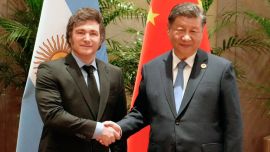Even if the elimination of the ‘cepo’ capital controls and the unification of the exchange rate are both still incomplete, April 11 here has a much stronger claim to be Liberation Day than April 2 in the United States. Economists in general and The Economist magazine in particular have hailed the cepo exit as a milestone in Argentina’s transformation but this columnist hesitates to consider it an electoral game-changer – there is both too much and too little time for that.
Tagging the new dollar in its first week is already an open question. When measured against the April 11 official exchange rate of 1,078 pesos, the initial figures of around 1,230 pesos this week constitute a devaluation but when measured against the parallel “blue” dollar of 1,375 pesos at the close of the previous week, 1,230 pesos represent a national currency gain – all a matter of perspective. Price bumps up to midyear look likely but the market seems too weak to sustain them beyond while the booster of US$12 billion given reserves by the International Monetary Fund (IMF) last Tuesday should stave off a run on the currency for half a year at least. Interest rates (key to not only investment but also to the credit keeping consumption deceptively high beyond actual purchasing power) are also worth watching.
Yet the aim of this column is not economic analysis but to monitor this year’s voting, which kicked off in Santa Fe last weekend with constituent assembly and various local elections. This is both easy and difficult to describe because at one level it was a landslide (albeit with only a third of the vote like the Labour Party in Britain’s last elections) for popular Unión Cívica Radical Governor Maximiliano Pullaro with powerful adjuncts such as the former nationally ruling party PRO and the socialists who ran this province between 2007 and 2019. Yet if we look at Rosario, by far the province’s largest city with over 30 percent of its population of 3.5 million, Pullaro won overall, as he did in all 19 departments, the Peronists triumphed at individual departmental level, while the libertarian television journalist Juan Pedro Aleart claimed the most votes among delegates – so who won in Rosario?
Such confusion arises from a double vote for the electorate of 2.8 million with one vote for 50 delegates elected by proportional representation for the province as a whole and the other within the 19 departments to define the other 19 delegates – in the latter category Pullaro won in 13, the Peronists topped four and the libertarians took the other two.
Across the province, Unidos para Cambiar Santa Fe (Pullaro’s list) took 34.6 percent of the vote, Más para Santa Fe (Peronist), 15.15 percent, La Libertad Avanza 14.1 percent, Somos Vida y Libertad (pro-life and far right under Amalia Granata) 12.35 percent, Activemos (old guard Peronist) 8.4 percent and Frente de la Esperanza (ex-boxer and outsider Alejandra Oliveras) 5.6 percent, leaving around 10 percent for six other lists (among which FIT leftists and a splinter Peronist PAIS list landed around 2.2 percent each). This worked out to 33 of the 69 delegates for Pullaro, 12 for the Peronists, 10 for the libertarians, seven for Granata, four for Activemos and three for Oliveras.
Less fragmented voting with PASO primaries serving as a filter and La Libertad Avanza teaming up with their ideological soulmate Granata would have led to over a third of the vote for Pullaro with around a quarter each for unified Peronists and libertarians as the dominant forces. Pullaro won comfortably enough while falling short of an absolute majority but his vote was at the lower end of his 32-38 percent range in the opinion polls – the triumphs against organised crime in Rosario could be losing steam just as taming inflation is nationwide. Within Peronism, Más para Santa Fe almost doubled Activemos – since the former’s leading delegate Juan Monteverde is an ultra-progressive (even if breaking with his erstwhile extremist ally Juan Grabois) while the latter represents trade unionists, business contractors, mayors and the party machine yearning for a more traditional Peronism, the Peronist constituency would seem to be the poor (of whom there are far too many both in this province and nationwide, despite the drop in poverty figures). Monteverde might also explain the feeble leftist vote. Last but not least, the national government must be disappointed with 14 percent when compared with the 63 percent going Javier Milei’s way in that province in the 2023 run-off – plenty of tactical voting in the latter, which would seem to yield better results than the dogmatic purism applied this year by Karina Milei’s team.
While only Santa Fe actually voted last week, there was an important development in Buenos Aires Province last Monday when ex-president Cristina Fernández de Kirchner yielded to the advanced elections called for September 7 by BA Province Governor Axel Kicillof while continuing to insist that not pooling all Peronist efforts on the same day was a terrible blunder. She thus averted a split in Kirchnerism while not giving up too much – whenever the vote anywhere, she occupies the Partido Justicialista (Peronist) chair at national level and her son Máximo at provincial level so they can still dictate the candidates. The PASO primaries might have been an alternative way of resolving the differences to end up with a unified Peronism but the Buenos Aires Province Senate already scrapped them last Tuesday with the lower house likely to follow suit.
Finally, this column is dedicated to tracking this year’s elections in this country but the results of Ecuador’s run-off last Sunday remain mystifying. Last February the leftist Luisa González seemed within a whisker of ousting President Daniel Naboa when she secured 44 percent of the vote in the first round (just 17,000 votes behind Naboa) while being pledged the run-off support of the powerful Pachakutik indigenous movement with over five percent of the vote. Opinion polls massively pointed to a similar dead heat last Sunday yet the result was remarkably similar to Argentina’s last run-off – 55.6 percent for Naboa and 44.4 percent for González (almost identical to her previous vote but perhaps not as static as it might seem). With none of the 45,000 opposition polling-booth scrutineers being able to substantiate her fraud claims, the creation of this new silent majority might be worth exploring with a view to our own voting here.



















Comments